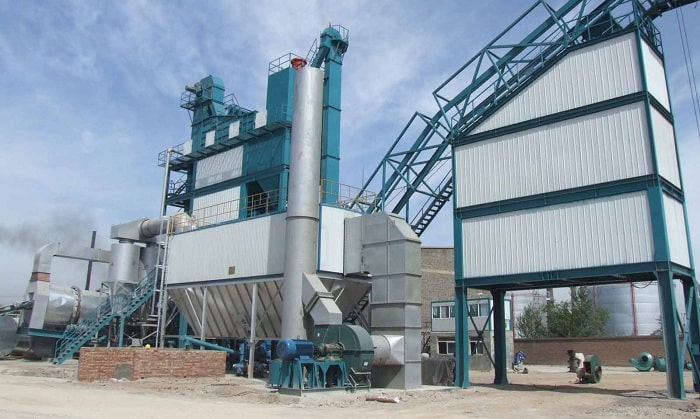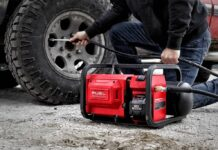Asphalt Mixing plants are used to produce hot-mix asphalt. It blends bitumen and aggregates for hot mix pavement material. The sums can be single-sized or a mix of various sizes and grades of materials.
Asphalt mixing plants are typically comprised of an aggregate supply system for cold which includes a drum dryer coal burner dust collector, coal feeder hot aggregate elevator vibrating screen and filler supply system mixing and weighing system, asphalt storage, and a bitumen supply and storage system.
Asphalt mixing plants are usually classified as batch mixing plants that create a sequence of asphalt mixtures and continuous mixing plants (traditionally made up of drums of the variety) that have an ongoing stream of asphalt.
This classification reflects not just the method of production but also the different demands for quality control. Plants can be modified to meet the production of asphalt mix made from recycled asphalt.
7 Different Types of Asphalt Mixing Plants
Many variations of continuous and batch drum mixing equipment have been created to meet the demands of project requirements.
Various kinds of asphalt batch mixers in India have a broad range of uses, which will be explained in the following.

Also Read: Every things You Want to know about R Mat Cleaner
#1. Mix plant for recycled asphalt
Modern Recycled Asphalt Mixing Plant offers top-quality technology for a reasonable purchase cost.
The Plant is equipped with multiple-coupled motors, which help reduce fuel use and lower maintenance costs. A powerful burner can be a further cost-saving feature, and the output capacity per hour makes the Plant a good fit for all businesses.
The Plant is equipped with multiple-coupled motors to reduce fuel consumption and maintenance expenses. Its efficient combustion engine is a further cost-saving feature, and the capacity of output per hour makes it an excellent fit for any company.
It offers outstanding drying performance and an easy and simple-to-adjust system to adjust the ratio of fuel and air for efficient combustion and pollution reduction.
The bag-house is additionally installed to ensure that suspension particle matter (SPM) levels are within limits set by the manufacturer. The Plant also allows using as high as 25 percent of hard RAP.
The Plant can be altered to utilize 25 percent recycled asphalt, allowing customers to convert mixes to the specific RAP design. Insulation can be added to improve the efficiency of dryers and decrease fuel consumption.
Silo pockets can use optional temperature probes. The Plant has multiple geared motors coupled, making it unnecessary to use linking mechanisms, reducing the need for maintenance parts. Wear parts are robust and straightforward to keep and replace.
Also Read: All about Shackledcraft Ad
#2. Mobile asphalt mix plant
Mobile asphalt plant systems have been designed and built using the latest technologies and are utilized to build roads on a smaller or medium-sized scale.
The system has been created and designed to ease assembly and disassembly for easy transfer from one location to another. In this kind of Plant, the dryer is precisely constructed to ensure the proper heating of aggregates while minimizing heat loss.
It is supported by steel rollers via steel tires, which have idlers and guide rollers, and comes with a sprocket segmented for driving. A fully automated control panel with feather-touch controls allows for controlling the amount and quality of the production.
The operator, in the comfort of an air-conditioned room, operates it. The entire system is wholly owned by manual or automatic control of the burners, load cell mixing temperatures, cold feet, proportions of bitumen, minerals, and other parameters.
Power by hand is available via an override control system. One deck of vibratory screens is used to eliminate the excess aggregate accumulated from the four-bin feeder.
Read: All About JCPShare the Joy com Overview and It’s Trend in 2022
#3. Portable asphalt mix plant
The latest product line has been made to meet the demands of modern-day manufacturers. Continuous-mix machines are available in relocatable, portable, and stationary variants.
Batch plants, which are targeted toward the export market, and specifically for domestic use, are designed to suit different requirements. This entire line of plants and their various capacities and features.
They are available in three sizes and designed to have maximum production capacities of either 80 or 130 tons each hour (72 or 118 MPH). They meet the requirements of various medium, small and large projects that require top-quality hot-mix asphalt.
Read: What is Imposter Syndrome
They have a compact, extremely portable design unique to a plant of this category, with the capacity to operate at a rate of 30 percent.
The most recent models set the benchmark for production, portability, and environmental sustainability with 140 tonnes/hr and a RAP mixing capability of up to 50 percent.
The Plant offers full-size features in a compact, highly-portable design. Each element is designed to enhance mix quality while allowing for setting up and portability.
Read: Imposter Syndrome: Stop Talking to Women about they have
#4. Mix plant for asphalt stationery
The stationary Plant for asphalt mix is an entire set of equipment for making asphalt mixture in large quantities.
It’s ideal for mixing asphalt mix, modified asphalt mix, and a combination of colored asphalt. This makes it a piece of essential equipment for highway construction projects and classified highway construction, port construction, airport construction, and construction.
There are a variety of stations for asphalt batching plants available on the market. Batch plants offer a consistent mix essential for the mix’s quality.
Each Plant’s process and component are designed to ensure that heating, feeding, drying, screening, and mixing are seamlessly integrated. Integrating all moving parts is as simple as 1 Control System, a cutting-edge technology with a user-friendly interface.
Related: Retail Business Review Industry Magazine
#5. Batch asphalt mix plant
In this kind of Plant, asphalt is made in small batches every 40-50 seconds, depending on how much capacity the Plant has and specific mixing requirements.
Newer models equipped with Counterflow technology continuously drum mix plants set new standards for the production of asphalt for 90 to 120 t/h production classes.
The main benefits of this Plant are its fuel efficiency, low carbon footprint, environmental protection, and capability to incorporate RAP. The Plant’s core is a counterflow dryer drum with a matched, fully variable long-nose burner.
In traditional continuous mixing plants using, the parallel flow heat transfer technique is employed when it is the case that the materials get heated and hot gases flow in parallel to one another within an identical direction.
The material will be heated in the counterflow dryer drum, and the hot gases will flow against each other in opposing directions.
This extremely efficient heat transfer system maximizes heat transfer from hot gases and radiation heat from the burning to the other aggregates.
The spraying of filler and bitumen occurs when hot mixtures are pushed behind the burner inside the same drum for drying.
#6. Asphalt Drum asphalt mix plant
This asphalt drum mixing plant procedure begins with feeding cold aggregates into bins for feeding. It usually has bins of three to four (or more), and the totals are loaded into containers according to their size.
Each compartment has separate gates that can be adjusted to control the flow of materials. A long conveyor belt beneath the bins transports the material to the scalping screens.
Modern models use a three-way heat exchange system, which ensures all-encompassing heat transfer to its full, resulting in higher efficiency and lower fuel consumption. The heat is transferred to aggregates through conductive, connective radiation, and connective.
The unique, field-tested flight design guarantees complete heat transfer, complete coating and mixing, fewer emissions, and the prevention of bitumen burning. The bins used in asphalt mixing machines are all-welded and modular, which allows the easy expansion of new containers to meet changing requirements.
The steep bin walls and valley angles allow aggregates to flow through the feeders, which reduces holding up to the materials in the corners and bridges them with sticky aggregates.
It is possible to choose direct heating or hot oil-heated bitumen storage tanks. Storage capacities vary from 10 to 50 tons. Indirect heating tanks are equipped with a Japanese-designed thermal oil heater.
The direct heating tanks are fitted with pressure jets that are imported automatically. Burners.
#7. Mobile Hot asphalt mix plant
The Mobile Hot batch is located in the drying cylinder. It comes with a fuel pump feeding fuel and an air blower to supply air. Air Blower is powered by the engine via a v-belt and has a sufficient capacity to support the burners available.
Storage Ring: The outlet end of the dryer cylinder is provided by a storage ring with buckets to lift hot aggregates to the chute for batching. The batching line is an available size. A lever releases the hot liquid from the drain and into the mixer paddle.
A thermometer is provided to monitor the temperatures of the rocks inside the chute. Wire rope hoist is supplied with a frame to lift it for simple and easy loading of bitumen from barrels into the boiler.
Bitumen and aggregates are mixed using an ad hoc mixer that has two shafts for paddles, which are mounted on arms and tips that are rotated at different speeds. The shafts are driven by gears and mounted on lubricated bearings.
The paddle tips can be replaced and coated with a special hard-facing alloy to give them greater longevity during operation. This arrangement is positive mixing as well as an even mix. It is discharged via a door located the lever operates.













